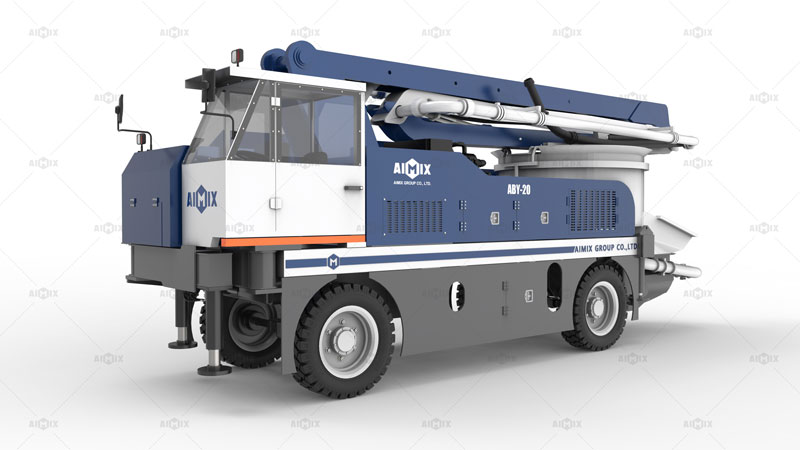Tunnel construction presents unique logistical challenges that conventional concrete placement methods struggle to address effectively. The confined spaces, limited access points, and demanding structural requirements necessitate equipment solutions that combine mobility, reach, and continuous production capability. A tire-mounted concrete boom pump integrated with a mixer represents a specialized approach to concrete placement in subterranean environments. This configuration addresses the fundamental limitations of separate batching and pumping operations by creating a self-contained production and placement system. The operational methodology involves continuous mixing and precise pumping directly at the point of application, eliminating the coordination delays and material consistency issues inherent in traditional delivery systems. This analysis examines the specific advantages and implementation protocols for this equipment combination in tunnel construction applications.

Operational Advantages in Confined Environments
The integration of mixing and pumping functions within a single mobile unit provides distinct operational benefits in the restrictive geometry of tunnel construction sites.
Mobility and Spatial Efficiency
The tire-mounted configuration offers superior maneuverability compared to track-based systems on prepared tunnel floors. This mobility allows the unit to be positioned at optimal locations throughout the construction sequence without requiring extensive site preparation. The compact footprint of the combined concrete mixer pump unit minimizes the occupied working area, which is particularly valuable in tunnel cross-sections where multiple activities must occur simultaneously. The ability to relocate the equipment quickly between different working faces enhances overall project scheduling flexibility and resource allocation efficiency.
Continuous Placement Capability
The synchronized operation of the mixer and pump components enables uninterrupted concrete placement, a critical factor in tunnel lining applications where cold joints must be avoided. While the pump is discharging concrete, the mixer can simultaneously prepare the subsequent batch, creating a seamless production cycle. This continuous operation methodology significantly reduces the total placement time for substantial lining segments compared to systems dependent on intermittent ready-mix truck deliveries. The elimination of waiting periods between truck arrivals prevents premature setting of previously placed concrete and ensures uniform material properties throughout the structural element.

Technical Specifications and Performance Parameters
The effective implementation of this equipment requires careful consideration of its technical capabilities relative to project requirements.
Boom Articulation and Reach Capabilities
The articulating boom system represents a crucial component for precise concrete placement in tunnel environments. Modern boom designs provide multiple articulation points that enable navigation around reinforcement cages, temporary supports, and other obstructions common in tunnel construction. The vertical and horizontal reach parameters determine the truck mounted concrete pump‘s effective working radius from a single setup position. For typical tunnel applications, boom systems with reach capabilities between 20-40 meters can service most lining and invert placement requirements without requiring frequent equipment repositioning. The remote-controlled operation allows precise nozzle manipulation from a safe distance, enhancing placement accuracy while minimizing worker exposure to the placement area.
Mixer Capacity and Output Synchronization
The mixer component must maintain adequate production volume to match the pump’s output capacity without creating bottlenecks. Mixer capacities typically range from 6-12 cubic meters, sufficient for continuous operation during lining placement cycles. The synchronization between mixing cycle time and pumping rate is managed through integrated controls that monitor both systems. This coordination ensures a consistent supply of freshly mixed concrete at the appropriate consistency for pumping, preventing both pipeline blockages from stiff mixes and segregation issues from overly fluid mixtures. The water-cement ratio control system maintains mix design consistency regardless of ambient conditions within the tunnel environment.
Implementation Protocols and Quality Assurance
The successful deployment of this equipment configuration requires established operational procedures and quality monitoring systems.
Material Handling and Supply Logistics
The efficient supply of raw materials to the mixer represents a key logistical consideration in tunnel environments. Cement, aggregates, and admixtures must be transported to the mini concrete pump truck location through the same access constraints that complicate traditional concrete delivery. Bulk material handling systems, including pneumatic cement transfer and conveyor-based aggregate delivery, provide practical solutions for maintaining continuous operation. The material supply chain must be calibrated to the production rate, with adequate buffer stocks maintained near the working face to prevent operational interruptions. This logistical planning ensures that the productivity advantages of the integrated system are not compromised by material supply limitations.
Quality Control and Performance Monitoring
The integrated nature of the mixing and pumping operation necessitates comprehensive quality assurance measures. Continuous monitoring of mix proportions, slump consistency, and pumping pressure provides real-time data on system performance. Automated recording of batch parameters creates a verifiable record for compliance with project specifications. Pressure sensors throughout the pumping circuit detect developing blockages before they become critical, allowing for proactive intervention. Regular sampling and testing of the placed concrete validates the effectiveness of the integrated system in maintaining design specifications throughout the placement process. This systematic approach to quality assurance ensures the structural integrity of the finished tunnel lining while maximizing the productivity benefits of the equipment configuration.
